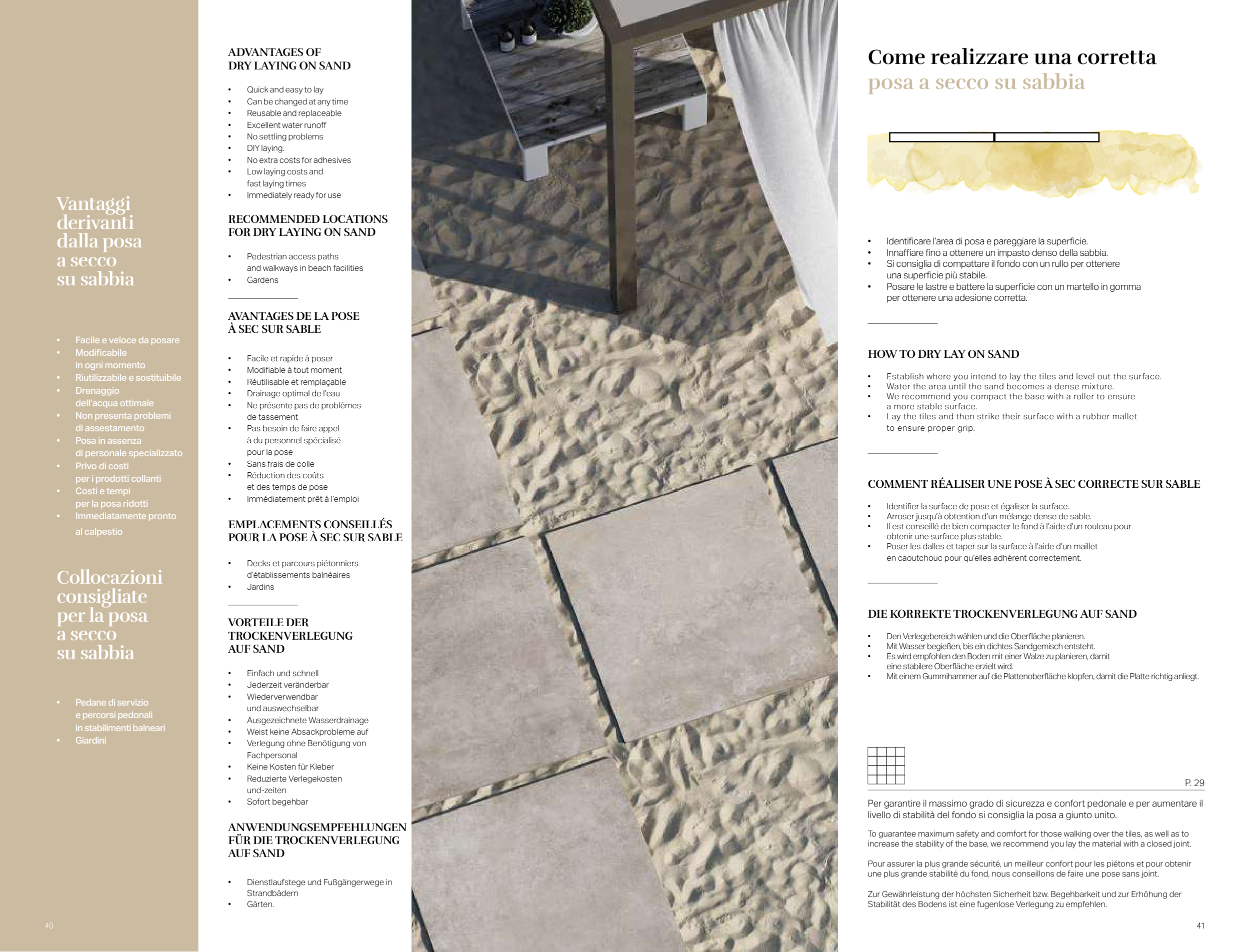Vantaggi
derivanti
dalla posa
a secco
su sabbia
•
Facile e veloce da posare
•
Modificabile
in ogni momento
•
Riutilizzabile e sostituibile
•
Drenaggio
dell’acqua ottimale
•
Non presenta problemi
di assestamento
•
Posa in assenza
di personale specializzato
•
Privo di costi
per i prodotti collanti
•
Costi e tempi
per la posa ridotti
•
Immediatamente pronto
al calpestio
Collocazioni
consigliate
per la posa
a secco
su sabbia
•
Pedane di servizio
e percorsi pedonali
in stabilimenti balneari
•
Giardini
ADVANTAGES OF
DRY LAYING ON SAND
•
Quick and easy to lay
•
Can be changed at any time
•
Reusable and replaceable
•
Excellent water runoff
•
No settling problems
•
DIY laying.
•
No extra costs for adhesives
•
Low laying costs and
fast laying times
•
Immediately ready for use
RECOMMENDED LOCATIONS
FOR DRY LAYING ON SAND
•
Pedestrian access paths
and walkways in beach facilities
•
Gardens
AVANTAGES DE LA POSE
À SEC SUR SABLE
•
Facile et rapide à poser
•
Modifiable à tout moment
•
Réutilisable et remplaçable
•
Drainage optimal de l’eau
•
Ne présente pas de problèmes
de tassement
•
Pas besoin de faire appel
à du personnel spécialisé
pour la pose
•
Sans frais de colle
•
Réduction des coûts
et des temps de pose
•
Immédiatement prêt à l’emploi
EMPLACEMENTS CONSEILLÉS
POUR LA POSE À SEC SUR SABLE
•
Decks et parcours piétonniers
d’établissements balnéaires
•
Jardins
VORTEILE DER
TROCKENVERLEGUNG
AUF SAND
•
Einfach und schnell
•
Jederzeit veränderbar
•
Wiederverwendbar
und auswechselbar
•
Ausgezeichnete Wasserdrainage
•
Weist keine Absackprobleme auf
•
Verlegung ohne Benötigung von
Fachpersonal
•
Keine Kosten für Kleber
•
Reduzierte Verlegekosten
und-zeiten
•
Sofort begehbar
ANWENDUNGSEMPFEHLUNGEN
FÜR DIE TROCKENVERLEGUNG
AUF SAND
•
Dienstlaufstege und Fußgängerwege in
Strandbädern
•
Gärten.
•
Identificare l’area di posa e pareggiare la superficie.
•
Innaffiare fino a ottenere un impasto denso della sabbia.
•
Si consiglia di compattare il fondo con un rullo per ottenere
una superficie più stabile.
•
Posare le lastre e battere la superficie con un martello in gomma
per ottenere una adesione corretta.
HOW TO DRY LAY ON SAND
•
Establish where you intend to lay the tiles and level out the surface.
•
Water the area until the sand becomes a dense mixture.
•
We recommend you compact the base with a roller to ensure
a more stable surface.
•
Lay the tiles and then strike their surface with a rubber mallet
to ensure proper grip.
COMMENT RÉALISER UNE POSE À SEC CORRECTE SUR SABLE
•
Identifier la surface de pose et égaliser la surface.
•
Arroser jusqu’à obtention d’un mélange dense de sable.
•
Il est conseillé de bien compacter le fond à l’aide d’un rouleau pour
obtenir une surface plus stable.
•
Poser les dalles et taper sur la surface à l’aide d’un maillet
en caoutchouc pour qu’elles adhèrent correctement.
DIE KORREKTE TROCKENVERLEGUNG AUF SAND
•
Den Verlegebereich wählen und die Oberfläche planieren.
•
Mit Wasser begießen, bis ein dichtes Sandgemisch entsteht.
•
Es wird empfohlen den Boden mit einer Walze zu planieren, damit
eine stabilere Oberfläche erzielt wird.
•
Mit einem Gummihammer auf die Plattenoberfläche klopfen, damit die Platte richtig anliegt.
Come realizzare una corretta
posa a secco su sabbia
Per garantire il massimo grado di sicurezza e confort pedonale e per aumentare il
livello di stabilità del fondo si consiglia la posa a giunto unito.
To guarantee maximum safety and comfort for those walking over the tiles, as well as to
increase the stability of the base, we recommend you lay the material with a closed joint.
Pour assurer la plus grande sécurité, un meilleur confort pour les piétons et pour obtenir
une plus grande stabilité du fond, nous conseillons de faire une pose sans joint.
Zur Gewährleistung der höchsten Sicherheit bzw. Begehbarkeit und zur Erhöhung der
Stabilität des Bodens ist eine fugenlose Verlegung zu empfehlen.
P. 29
41
40


